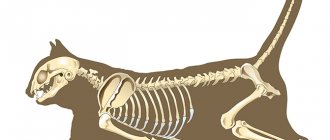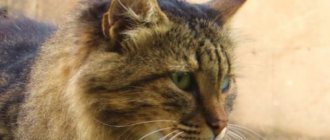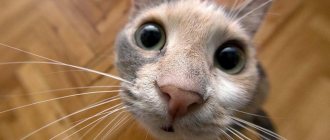4467Pavel
The reason that a cat chases its tail lies in its biology. Felines are hunters and, unlike dogs, can chase their own bodies. The question is how often they do it.
Everyone knows that everything is good in moderation. Therefore, if the owner of a cat notices that she often runs after her tail a lot, it is worth contacting a veterinarian. He will find out why the animal behaves this way and whether it is related to a health problem. The impairments may be physical or mental.
© shutterstock
Tail - simulator
When a young cat, not yet a year old, begins to chase its tail, it learns to hunt small and fast prey. With the help of its tail, it practices movements and techniques useful for hunting.
Before attacking the tail, the kitten wags its tip. This is how he teases himself. Decorative breeds, although they are not hunters, do need intellectual development.
The cat plays and develops useful skills. It’s another matter if the pet is over a year old, but he continues to play with his tail for a long time. Then the reason is related to a health problem.
How to understand a cat's mood by its tail
Our brain is designed in such a way that it is good at reading emotions from facial expressions, but gives up when it comes to deciphering the behavior of an animal. People subconsciously attribute human emotions to the behavior of pets, but this is fundamentally wrong. However, there is a “translation” from cat language to human language.
The tail is held by a pipe
Why cats love boxes and bags: why do they climb into them?
When a cat raises its tail vertically and holds it straight, this indicates the friendliness of its owner. By this action, the pet makes it clear that he is in a friendly mood and is ready to play and be cuddled.
This is usually how cats greet their owner, thereby expressing the feline equivalent of human joy at the sight of a friend. Sometimes this means that the cat is going to beg some tasty treat from the person or asks to pet itself.
Held at a 45 degree angle
If the tail is raised at an angle to the floor, this shows that the cat is hesitating. You need to be on your guard, because when she makes up her mind, she can reveal anything: scratch the new leather sofa, shit in her shoes, or ask to be caressed.
Tail raised and swaying
If the furry limb is raised and sways from side to side, then this is a signal that the cat is in a playful mood.
Important! Don't grab cats by the tail: they don't like it.
A child tortures a cat
In addition to causing them pain, such rash actions can lead to urinary incontinence, limb injuries, and in some cases even paralysis of the hind legs.
Raised up and twitching
This is a variation of expressing feelings using a vertically raised tail. In this way, the cat expresses sincere joy towards the object of its attention.
It can be either the owner or the guest who plays or pampers the pet with treats. Other pets love to enjoy small treats too. For example, dogs love to shake their tail.
Raised up with a curved tip
In this state, the cat needs no one to touch or bother it. Maybe she just wants to lie there and purr until she feels better.
It’s difficult to say what mood she’s in now - it’s absolutely neutral, that is, neither good nor bad, no anger or joy. It's worth leaving her alone so she can be alone for a while.
The tail is kept parallel to the floor
The cat treats the person well, considering him her friend. A good sign that speaks of her favor and friendliness.
The cat's tail is down
The cat was scared of something. It's difficult to say what caused this. Cats are very inquisitive by nature, and because of their curiosity they often get into different stories. Therefore, at any given moment in time, a cat can be frightened by anything.
But if a person scares her, she needs to watch her tail. When it starts to twitch from side to side, which will mean that the cat is starting to get angry.
The cat's tail hits the floor
The cat has fallen to the ground, its ears stand up, and its tail is beating the ground excitedly? It goes without saying that there is some kind of prey in front of her: a mouse, a bird, a fly, a toy, a banal shadow or a sunbeam. Her hunting instincts awoke.
On the other hand, if a cat lowers its tail and hits the floor with it, then this may also indicate irritation and even aggression.
Fluffed and raised up
The cat is attacked by fear, but she is trying to overcome it and appear larger than she really is. Her tail stands on end, she herself wants to scare her offender.
For reference: all mammals, including humans, have a similar evolutionary mechanism, only we get goosebumps.
Down and out
Speaks of the cat's wariness. You need to behave carefully: any sound, noise or wrong movement of a person - and the cat will begin to act. What exactly he will do - run away to hide or go on the attack with his claws out - depends entirely on the fighting qualities of the mustachioed pet and on his character.
Cats' claws leave quite painful scratches.
Cat's tail tucked between hind legs
Extreme degree of fear. The cat is so scared that it can neither run away nor resist. Whatever the reason, the pet completely capitulated to the danger.
Do not underestimate the significance of such behavior: a person in a similar situation would most likely stand rooted to the spot and stutter from fear.
The cat's tail twitches
The cat is intrigued by what is happening or interested in something that he sees for the first time. This is how he reacts to the incomprehensible and unknown to him.
Tail raised when turned backwards
For a person who does not know the principles of cat psychology, such behavior of a four-legged animal would mean an expression of complete contempt. However, everything is much better: this is how cats make it clear that they completely trust the person. So much so that they are ready to turn to him with their most unprotected side.
It is important for a cat owner to find mutual understanding with him, and knowledge of why cats wag their tail plays an important role in this. Having understood the intricacies of cat behavior, a person will be able to understand his little pet even better. After this, getting along with your furry pet will be much easier.
Needs for development of intelligence
Don't be afraid of pets chasing their tails. Cats are allowed to hunt for parts of their body at a young age. If the game lasts for a long time, you should ask a specialist about possible developmental disorders.
To develop your pet's intelligence, you can invite him to play special games. They will help the animal acquire the skills necessary for hunting. Toys can help your pet.
Types of toys popular among cats:
- feathers attached to a holder;
- bells on a cord;
- beanbag;
- a toy filled with catnip;
- interactive games on a tablet.
© shutterstock
If games do not help and the animal continues to run in circles after its tail, you should think about a mental disorder.
How old is the cat?
The first thing you need to pay attention to is age.
Kittens exhibit many unique behaviors as they undergo training during this stage of life. Almost all kittens will catch their tail at some point - this is completely normal. Kittens are "notorious" for attacking anything that is close to them, especially if the object they spot moves. These could be plant leaves, some strings, toys on sticks and (why not?) your own tail. Being a born hunter, the kitten, jumping on moving prey, obeys the natural instinct of pursuing a potential victim.
This behavior helps the kitten to practice the art of hunting, without which it would not survive in the wild. As kittens grow older, they gradually abandon this pattern of behavior. Catching is observed less and less often, and by the age of one year it practically disappears.
If the kitten constantly attacks his own tail, and especially if he bites it, you need to do everything possible to redirect his energy to other games. There are an endless number of different toys, including some that resemble a cat's tail, but in most cases, an ordinary (and very cheap) stick with a bow tied to it gives excellent results.
If tail hunting has not stopped after reaching one year of age, you may not need to worry, but it would be a good idea to consult your veterinarian.
Neurosis
In stressful situations, a cat may try to catch its own tail. If this play is compulsive, a veterinarian may diagnose it as neurological. But this term is very broad. It implies deviations in the functioning of nerve endings.
About 10% of cats chase their own tail due to extreme stress. It can be caused by external stimuli such as the sound of a vacuum cleaner turned on, a buzzing drill, etc.
The specialist must clarify what exactly is wrong with the cat. If he is not specific, it is better to contact another veterinarian.
When to seek medical help?
Although tail catching is usually just a way to have fun, the habit can be a sign of a medical problem. Such problems are quite numerous, they can have different severity and cause different consequences. The most common among them are:
- Allergy. If your cat has been in contact with something new (such as carpet) or eaten some new food, she may have had an allergic reaction, causing itching or discomfort in the tail area.
- Feline hyperesthesia. The cause is currently unclear, but is considered to be a form of feline schizophrenia. Sometimes it leads to fixation of attention on the tail, which manifests itself in waving it, catching it or biting it. Excessive licking is possible, sometimes to the point of complete loss of hair in some areas.
- Diseases of the anal glands. Can cause pain, which encourages tail chasing, especially after defecation.
- Fleas. They often choose to live in the area under the tail and just above its base. In addition to the fact that the bites themselves can also be quite painful, an allergy to flea bites is possible. If it happens that your cat is allergic to flea bites, even a single bite can cause an acute allergic reaction.
If a cat begins to catch its tail, although it has not done this before, perhaps the reason lies among those listed. In such cases, it is worth contacting a veterinarian without delay to make sure whether such behavior is a symptom of a more serious disease.
It is believed that a cat chases its tail to entertain itself. In most cases, this statement is true and there is nothing to worry about. There are many safe reasons for this behavior, and the first of them is training.
All cats have a hunting instinct to a greater or lesser extent. Chasing your tail is a form of training. If you observe, before the tomfoolery begins, the four-legged wags the tip of its tail slightly, as if teasing itself. Decorative cat breeds do not have pronounced breadwinner skills, but they still need to develop intellectually.
Injury
The cause of tail chasing may be due to injury. Young kittens are constantly jumping. This leads to a bruise or fracture. By trying to catch the tail, the kitten signals a problem.
If an adult cat is chasing its tail, the cause may be a pinched nerve. To find out the cause, you need to meet with a veterinarian. An x-ray will help clarify the diagnosis.
© shutterstock
Having fun
Adult cats usually come to the conclusion that the tail is part of their body, so they are not very interested in hunting it. But sometimes a pet’s life is so boring and monotonous that, out of despair, he begins to entertain himself in such a simple way.
The owner should pay attention to the existing problem and try to devote more time to the four-legged pet. You also need to make sure that there are various toys in the house - balls, mice, etc. By switching attention to these bright objects, the animal will forget about its habit.
Blocked anal glands
The reason why a cat twitches its tail and runs can be a blockage and inflammation of special glands. They are located in the anus and contain a secretion with a pungent odor. When the substance in the glands cannot come out along with the feces, the inflammatory process begins.
The cat experiences pain and itching. She gets angry and tries to influence the sore spot by biting her tail. Cleaning the glands can help in the situation. However, before agreeing to this procedure, the problem must be diagnosed.
If you clean healthy glands, there is a high probability that the procedure will have to be performed regularly.
What does it mean when a cat wags its tail?
Scientists have an interesting answer! A cat has many reasons to wag its tail. It is an expression of many emotional states. Sometimes they are completely contradictory.
Indeed, cats seem calm and self-sufficient to us. That is until we get to know them better. By reading their behavior correctly, we can understand that they regularly and constantly signal to us about their intentions and mood. For this, three types of signals are used: smell, body language, vocalization. By understanding their meaning, we begin to understand when our cat is relaxed and when she feels insecure. But how to understand all these signals? You can read a lot from the movements of the tail! It’s always right in front of us: why does the cat wag its tail?
Itching
When an animal chases its tail, especially if it is old, it may indicate the presence of parasites. Fleas and ticks bring severe discomfort to your pet. To temporarily avoid the itching, the cat begins to bite its tail. The pain from the bite briefly distracts from the annoying itching.
Allergies and dermatitis also cause discomfort. The problem may be caused :
- taking low-quality food;
- individual components of household chemicals;
- contact with insect poisons.
It is also worth remembering the itching in the anal area. It is often associated with the intake of low-quality dry food. Its granules do not completely dissolve in the cat’s digestive tract and are passed out with feces. This is how they scratch the intestines and anus. The problem may also be related to worms.
Having fun
Adult cats usually come to the conclusion that the tail is part of their body, so they are not very interested in hunting it. But sometimes a pet’s life is so boring and monotonous that, out of despair, he begins to entertain himself in such a simple way.
The owner should pay attention to the existing problem and try to devote more time to the four-legged pet. You also need to make sure that there are various toys in the house - balls, mice, etc. By switching attention to these bright objects, the animal will forget about its habit.
To please the owner
There is an unlikely chance that your pet may be chasing its tail in circles to get its owner's attention. Perhaps one day the kitten was practicing catching imaginary prey. The owner saw this and rewarded him with attention, delicious food, and praise. The kitten remembered this moment and continues to perform the same actions even when it has matured.
© shutterstock
The owner should not encourage such behavior. In excitement, a pet can injure itself. When you see a running kitten, it is better not to grab the camera to film what is happening, but to show it to the veterinarian. A funny sight may hide a serious problem.
Is it possible to do without it?
Very often, homeless cats lose their tails as a result of some kind of injury; incidents of this kind occur much less frequently with domestic pets, especially if they do not go outside at all and do not climb trees for this reason. A number of breeds do not have a tail at all from birth, or it is so small that it is almost invisible. Many pet owners ask a completely rational question: is it possible for cats to do without this organ?
If the tail is absent in a purebred animal and is a characteristic feature of its breed, then the tail does not have much significance for such pets as for pets that have lost their tail due to injury or serious illness. In principle, an ordinary cat can live just as good a life without a tail as with a tail. Perhaps part of this life will no longer be so comfortable, but the pet will be able to convey all its feelings with its eyes, meows, and paws.
The course of labor in cats
The duration of an animal's pregnancy depends on the number of developing fetuses; the more kittens, the earlier birth can occur. If your pet is pregnant with one or two babies, the period of birth may be delayed. As a rule, pregnancy lasts 65-75 days.
The cat notifies that labor has begun by its behavior: the pet is fussing, breathing heavily, the expectant mother is looking for a secluded corner, and trembling runs through the animal’s body. The birth process in a cat should not last more than a day from the time of the first contractions. Consists of several phases, namely:
Little fluffies are born at the pushing stage.
- Preparation of channels. The cervix dilates up to 12 o'clock.
- Contractions. Smooth muscle muscles contract.
- Attempts. The abdominal muscles are activated.
- The process of giving birth to a kitten. Contractions and attempts alternate, and the fetus comes out.
- Cleansing from afterbirth. After 10-20 minutes. after the babies arrive.
- Contraction of the uterus. Minor bleeding for 1-2 days. after the birth of kittens.











